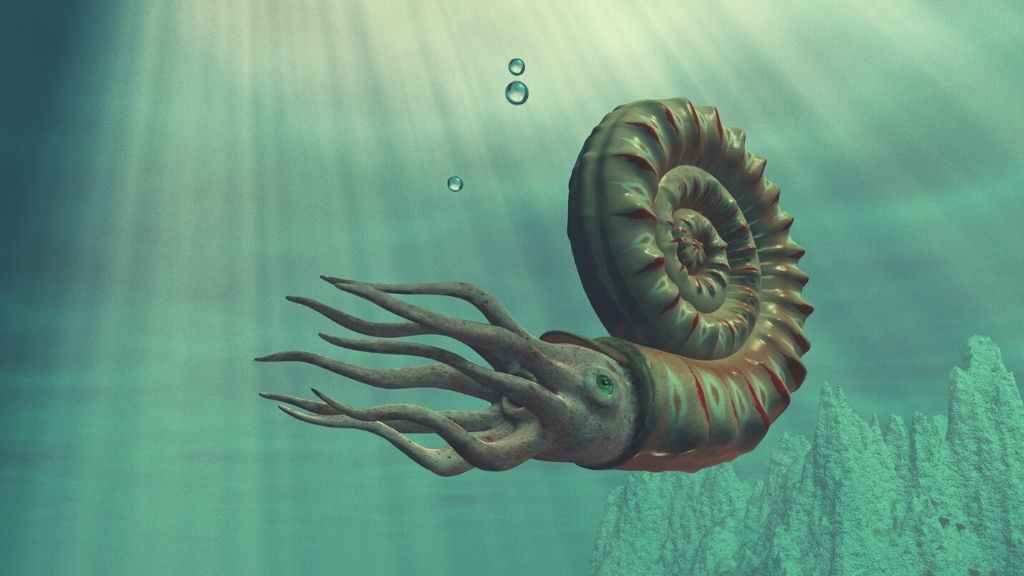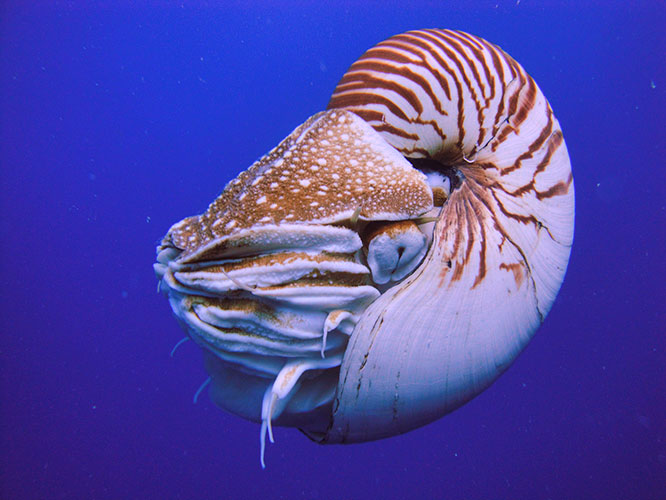So about five hundred million years ago, give or take, there was this little creature called Plectronoceras. It was about 2 cm long — just under an inch — and it had a conical shell with a bunch of tentacles sticking out. It was a cephalopod, an early member of the group that includes octopuses and squid. And it was an /armored/ cephalopod, with most of its soft body protected by that hard little shell.
Let’s pause here and rewind: this was five hundred million years ago. That’s the late Cambrian, if you’re a geology nerd. It’s before the dinosaurs. It’s before sharks or cockroaches or ferns. This is *old*. Complex life had barely gotten started. Life in general was pretty much confined to the oceans. But there were no fish yet — just invertebrates. Half a billion years, yeah? Long, long time.
And a lot of the stuff swimming around was weirdly alien. Again, if you’re a geology nerd, you know about stuff like Opabinia, Anomalocaris, or Hallucigenia. If you don’t, then let’s just say that you wouldn’t have recognized much from those ancient seas. Not just “no fish”. There were no clams or lobsters, no starfish or barnacles or crabs or anemones, no coral or kelp. The world was new. Those things hadn’t evolved yet.
But almost from the beginning, there was this thing: shell, plus tentacles.
If you have even the slightest interest in the ancient world, you’ve probably heard of ammonites. The usual narrative goes something like this:
“Ammonites were armored cephalopods, relatives of squids and octopi (1), but with a hard external shell. They lived in the oceans for hundreds of millions of years. Then they all died out in the mass extinction at the end of the Cretaceous, the same extinction that wiped out the dinosaurs. Today there are only chambered nautiluses, which look somewhat like ammonites but are a different sort of creature.”
And this is true as far as it goes, but it misses a couple of key points.
First, ammonites were just one sort of armored cephalopod. That design seems to have evolved independently several times. And… sure, think about it. It’s actually a great design. It combines the two best features of being a mollusk: a hard protective shell, and grasping manipulative tentacles. Modern mollusks have to choose one or the other. But hey, por que no los dos?
Armored cephalopods were free-swimming, or rather free-floating: they filled their shells with gas, so they floated along at zero buoyancy.(2) They were mostly slow, but could put on sudden short bursts of jet-propelled speed, just enough to catch prey or avoid danger. They didn’t “rule the seas” or anything like that, but for hundreds of millions of years they were around pretty much everywhere, in every marine ecosystem from the poles to the equator.
If you want to buy a fossil today? and you want something that looks cool but is not too expensive? A fossil ammonite is your go-to. Some years back my kid found one, pretty intact, just lying in a field. That’s how ubiquitous they were. Because it was a great design, yeah? Like the cockroach or the shark: basic, efficient, central.
Second thing, the chambered nautilus. It’s not an ammonite, no, but it’s like an ammonite — it’s another armored cephalopod, a spiral snail-like shell plus a bunch of tentacles.(3) But where earlier armored cephalopods were everywhere, the nautilus is restricted to a small-ish patch of ocean in the western Pacific, from northern Australia through Indonesia up to Vietnam or so. And while ammonites floated boldly everywhere, the nautilus is a shy creature that lives fairly deep down, mostly in the twilight zone 100 to 500 meters deep.
(Years ago, I used to scuba dive in that area. My dive instructor told me that a nautilus never comes above 100 meters depth unless it’s seriously ill or injured. Meanwhile, a recreational diver should never go below 40 meters depth — nitrogen narcosis, oxygen poisoning, the bends, just don’t. “So if you’re diving and you see a nautilus,” he said, “at least one of you is in big trouble.”)
Okay, so: why? Why is the nautilus restricted to this small area, when older armored cephalopods roamed worldwide? Is the nautilus just… worse? An inferior design, or something?
No. Here’s where things get mysterious and interesting. After the asteroid hit, the ammonites all died out. But chambered nautiluses survived, and they thrived! They weren’t as ubiquitous as the ammonites, but for about 30 million years they were found all over the world. Dozens of species, all sorts of different habitats. The “shell, but also tentacles” design was still solid.
But then around 30 million years ago — halfway through the Age of Mammals, give or take — something happened. The nautiloids started disappearing. Fewer species, less diversity. Bit by bit they shrank back into their current small range.
What happened halfway through the Age of Mammals? Well, here’s one clue: the nautiloids’ long retreat showed a pattern. It wasn’t everywhere and all at once. They disappeared first in the northern arctic regions; then in the Antarctic; then in temperate zones; finally across most of the tropics except that one small patch. This pattern suggested a culprit: a warm-blooded predator that evolved in the Arctic and then spread around the world.
But… the armored cephalopod design had been around forever. They’d been living with predators for *half a billion years*. Sharks. Primitive armored fish. Not-so-primitive modern fish. In the age of dinosaurs, they had to deal with ichthyosaurs, plesiosaurs, and mosasaurs. Back in the Paleozoic, they were hunted by eight-foot-long giant sea scorpions. Way back in the Cambrian, they had to live with the anomalocariids. In the early Age of Mammals, there were primitive whales and sea-going crocodiles. The armored cephalopod design took them all in stride and kept going.
So what happened?
— The authors of this paper here think that they’ve found the answer.
To understand, we have to zoom in on exactly what happens when something tries to eat an armored cephalopod. Threatened, the beast withdraws its tentacles into its shell and clams up. Okay, so now either you’re big enough to crunch through the shell, or you’re not. We know that some large predators did crunch through, because we’ve found fragments of ammonite shell fossilized in the stomachs of plesiosaurs and ancient sharks and such.
But if you do that, now you have a stomach full of tasty mollusk meat… mixed with unpleasantly sharp and indigestible shell chunks. An option if you’re hungry enough, but hardly ideal. Shark, ichthyosaurs, marine crocodiles: it’s not that they couldn’t eat armored cephalopods. It’s just that it usually wasn’t worth it. Predators have to do a cost-benefit analysis, yeah? And for half a billion years, armored cephalopods were in the black.
But then something evolved with a feeding apparatus that could separate the meat from the shell. And suddenly, armored cephalopods were in the red.
The paper says: it was seals.
Seals — pinnipeds, if you’re fancy — aren’t usually that large, and aren’t usually apex predators. (Predators, absolutely yes. Apex, no.) (4) So what do seals have that mosasaurs and sharks and sea scorpions didn’t have?
Lips. Seals have lips. Lips, cheeks, and a muscular tongue.
A seal can grab a shelled prey, and puncture the shell with sharp strong teeth — and then just *schlorp* out the tasty meat inside. The technical term for this is “suction feeding”. Pinnipeds generally are good at it, and some are so good that they prefer to eat shelly prey — clams, crabs, mussels, whatever — and don’t eat much else.
Stuff that lives on or near the ocean floor — clams, crabs, lobsters, and such — could evolve various defensive and avoidance strategies. But free-floating armored cephalopods? All they had was a quick burst of speed, and that wouldn’t help much against a hot-blooded predator that could maintain high speeds much longer.
And everything else matches, too. Pinnipeds evolved about thirty million years ago. They showed up first in the colder parts of the northern hemisphere, then in the Antarctic, then in temperate zones. Even today, although there are some tropical species, they’re mostly cold-to-cool water creatures.
And — here’s the smoking gun — the one part of the globe they still haven’t colonized? The southwestern Pacific, from northern Australia across Indonesia. The modern range of nautiloids is exactly the one part of the ocean that those sucking, slurping seals haven’t reached yet.
And that’s all: just a little story about evolution. “Persons attempting to find a motive in this narrative will be prosecuted; persons attempting to find a moral in it will be banished; persons attempting to find a plot will be shot.”
当盔甲遇见嘴唇 When Armor Met Lips
原始链接: https://crookedtimber.org/2024/03/16/occasional-paper-when-armor-met-lips

你好! 这是您的新帖子: ````php
<文章>
<标题类=“条目标题”>
post_parent): ?>
>
<节类=“条目内容”>
false]); ?>
comments): ?>
相关文章
原文
联系我们 contact @ memedata.com